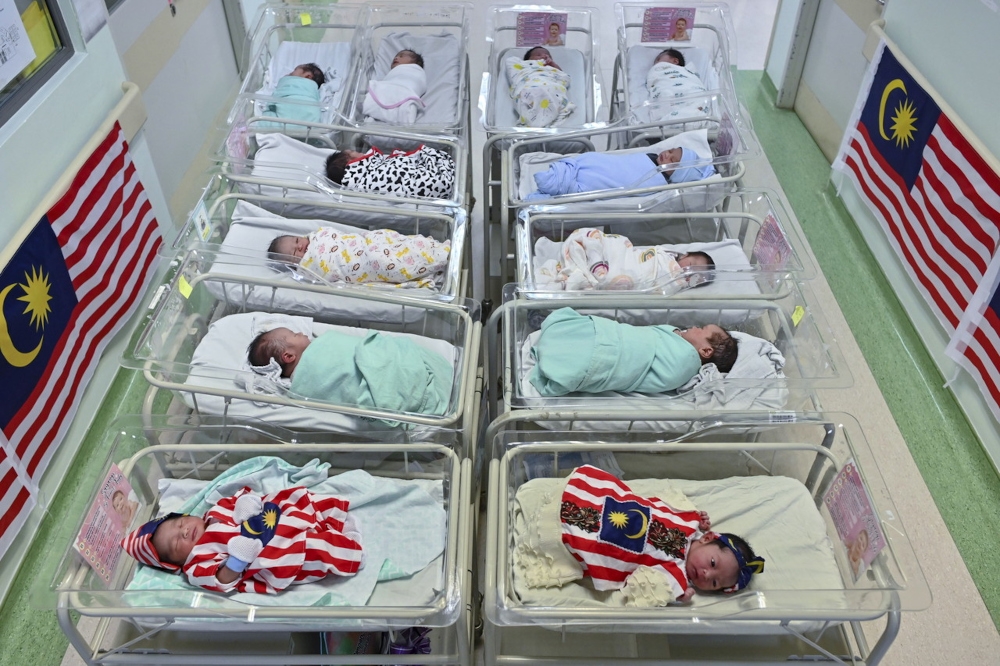AUGUST 4 — “Malaysia records fewest births ever, fuelling population decline concerns”
“Only three states in Malaysia produce enough babies to replace their populations”
“Malaysia’s labour shortage due to declining birth rates”
These media headlines capture common narratives around fertility rates. However, what they often obscure are the harsh realities individuals and couples grapple with when making decisions about their fertility, families, and futures.
Why is it that people all over the world, not just in Malaysia, are having fewer children? What are the reasons or conditions that are leading couples to have smaller families? Do people these days even want to have children?
The United Nations Population Fund (UNFPA) recently commissioned an online survey to shed light on this issue, and the key finding is that people do want children. Most desire two or more, yet 1 in 5 said they do not expect to be able to form the families they desire or have the number of children they aspire to have.
Why? Why are fertility aspirations not being met? The top three responses given to the survey were economic and financial hardships, gender inequality, and worries about the future.

According to the author, the crisis is not about dropping fertility rates, declining birth rates, or too few babies being born. The crisis is one of too little reproductive agency. Too many do not have the capacity to exercise informed, empowered decision-making over their reproduction. Too many are unable to realise their fertility aspirations. Too many are constricted in their choices. — Bernama pic
The issue at hand is therefore not that people don’t want to have children, but rather, they feel they can’t due to the conditions surrounding them.
The crisis is not about dropping fertility rates, declining birth rates, or too few babies being born. The crisis is one of too little reproductive agency. Too many do not have the capacity to exercise informed, empowered decision-making over their reproduction. Too many are unable to realise their fertility aspirations. Too many are constricted in their choices.
And choice extends beyond the ability to say yes or no to having children. Real choice is about having access to a full range of conditions that enables one to make a free and informed decision about whether to have children, and if yes, with whom, when, and how many.
Barriers to reproductive agency
The UNFPA survey, conducted by YouGov on more than 14,000 people across 14 countries, forms the basis of the latest edition of UNFPA’s annual flagship State of World Population report, entitled The Real Fertility Crisis — the pursuit of reproductive agency in a changing world.
UNFPA appreciates that this year’s publication was launched in Malaysia by Datuk Dr Noraini Ahmad, the Deputy Minister for Women, Family and Community Development, on behalf of the Minister, Datuk Seri Nancy Shukri, during a World Population Day commemoration event by the National Population and Family Development Board (LPPKN). We could not agree more with the Deputy Minister’s acknowledgement that young people want to have families but face real social and economic challenges.
We further echo Minister for Women, Family and Community Development Datuk Seri Nancy Shukri’s statement on the need for a supportive ecosystem that addresses obstacles to family formation.
Economic constraints
In every one of the 14 countries surveyed for the 2025 UNFPA report, people cited economic constraints as the number one barrier to their reproductive agency. And while Malaysia was not part of this survey, the findings have much relevance to the prevailing context here.
- Almost 2 in 5 said financial limitations had led or were likely to lead them to have fewer children than initially desired.
- 1 in 4 said unemployment or job insecurity was a factor.
- 1 in 4 cited housing limitations, whether a lack of space or high costs, as a factor.
Eleven years ago, in LPPKN’s Malaysian Population and Family Survey 2014, many surveyed said they were unable to fulfil their fertility desires. That survey found that the average number of children desired by married women was 4, but their actual number of children was 2 to 3. Similar to the UNFPA study, the LPPKN survey found that the number one barrier stopping Malaysian couples from having more children was financial constraints. LPPKN’s 2024 survey is presently underway, and we eagerly await the results.
Gender inequity
A second common thread was how gender inequality, specifically the unequal division of care work, deepens the fertility crisis.
- Across the 14 countries, 1 in 10 said that a lack of sufficient childcare options was a barrier.
- 1 in 10 also said having a partner who was not involved enough in housework or childcare led them to have fewer children.
In the 2014 LPPKN study, “childcare problems” was the biggest reason why Malaysian women respondents said they left the workforce. More than 34 percent of working women said they needed childcare centres at their workplace.
Last year, an Institute of Strategic and International Studies (ISIS) policy paper estimated that 3 million women had dropped out of the workforce or reduced their work hours to take care of children and/or older persons. Insufficient childcare facilities are causing women all over the world to cut short their careers while also holding them back from fulfilling their fertility aspirations.
Anxiety about the future
A third theme in the UNFPA report survey was that 1 in 5 said worries and anxiety about the future had led or would lead them to have fewer children than desired.
People, especially young people, who are optimistic about the future are more likely to pursue the lives they want for themselves and their families. However, global conflicts, economic instability, and climate disasters are causing many to fear that their world, and the world their children will inherit, will be less hopeful than the one their parents lived in.
Beyond the conditions to enable them to make free and informed reproductive choices, people need to have trust in government and institutions, and hope that the future will be one where their choices are supported.
Asking what matters
Across modern history, governments have attempted to control fertility by demanding individuals align their reproductive decisions with the needs of the state, and of late they have opted for the “baby bonus” financial incentives to encourage childbearing. What those incentives resulted in, our report found, is couples bringing forward the timing of births. In the long term, the strategy has not resulted in more births or reverse the downward trend of fertility rates.
The desire for children remains high, as data from our report survey shows, and government interventions need to go beyond short-term solutions and one-off incentives. The emphasis and investment need to be directed towards addressing the fundamental misalignment of systems, environments, and policies with the lived realities of individuals. Baby bonuses do little to ensure long-term financial security, job security, income stability, and adequate housing conditions — essential considerations when it comes to family formation.
This is why UNFPA calls on governments to expand their focus beyond total fertility rates and fertility targets, and focus efforts instead on designing strategies that provide an enabling environment for fertility aspirations to be achieved.
This entails, firstly, asking individuals, especially young people, about their desires and concerns. Leaders and policymakers then need to listen to their voices, understand their concerns, recognise their realities, and let that inform policymaking.
We believe that Malaysia would benefit from a survey similar to the one in our 2025 State of World Population report. A survey asking young people — tomorrow’s mothers and fathers — about their reproductive aspirations, their attitudes towards family planning, and what barriers are standing in the way of their family formation goals. Because, again, the first step to building trust around reproductive agency is to ask and listen. Only then can we design interventions to target the right issues without being misguided by assumptions.
Malaysia, as the Asean chair and recently elected host of the Asian Forum of Parliamentarians on Population and Development (AFPPD) secretariat, is incredibly well-poised to demonstrate its leadership in enabling reproductive agency for all.
Reproductive agency for all
On a recent trip to a Jakun Orang Asli village, our team met 17-year-old Riah at a literacy programme on sexual and reproductive health and rights and gender-based violence prevention.
Riah’s story was that she had dropped out of secondary school during the Covid-19 pandemic after she did not have the means to keep up with online lessons. At 14, she found herself pregnant and later married her child’s then 16-year-old father.
Pregnant with her second child when we met her, the programme was Riah’s first time learning about bodily autonomy, consent, gender stereotypes, contraception, common menstrual and reproductive health conditions, where to get help in the case of gender-based violence, and what the law says about all these issues. She was among the most engaged and enthusiastic participants, and told us she was “very, very happy” to learn about things so relevant to her fertility, family, and future.
Riah’s story underscores how life-transforming comprehensive sexuality education can be, and the importance of UNFPA’s life-course approach.
The life-course approach means investing early in age-appropriate comprehensive sexuality education and then providing access to sexual and reproductive health and rights at reproductive age. At working age, individuals need to be able to access family planning and family-friendly policies. With this lifetime of reproductive agency, as they age, individuals would have accumulated the health, skills, and resources needed to age healthily and productively in their older years.
As Malaysia navigates its demographic transitions and 13th Malaysia Plan goals, reproductive agency must be seen as central to the nation’s development. This is because the pursuit of such agency, and not prescriptive fertility targets, is what will unlock both demographic resilience and individual wellbeing.
As demonstrated in the 2025 State of World Population report, the pathway to reproductive agency lies in addressing economic and gender barriers, and in creating an enabling and trusting environment so that young people like Riah feel supported to have the families and futures they want.
* Dr Julitta Onabanjo is the United Nations Population Fund (UNFPA) Country Representative for Malaysia and Country Director for Thailand.
** This is the personal opinion of the writer or publication and does not necessarily represent the views of Malay Mail.






